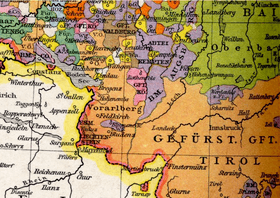Königsegg
| Lordship (Barony) of Königsegg Herrschaft (Freiherrschaft) Königsegg | |||||||||
|---|---|---|---|---|---|---|---|---|---|
| 1192–1806 | |||||||||
 Coat of arms
| |||||||||
| Status | Lordship | ||||||||
| Capital | Aulendorf | ||||||||
| Government | Lordship | ||||||||
| Historical era |
Middle Ages Early modern period | ||||||||
• Lordship | 1192 | ||||||||
• Raised to barony | 1470 | ||||||||
|
1622 | |||||||||
| 1629 | |||||||||
• Inherited by Aulendorf | 1663 | ||||||||
|
1804 | |||||||||
|
1806 | |||||||||
| Area | |||||||||
| 1806 | 160 km2 (62 sq mi) | ||||||||
| Population | |||||||||
• 1806 | 3000 | ||||||||
| |||||||||
Königsegg was a state in the southeastern part of what is now Baden-Württemberg, Germany. It emerged in 1192 as a lordship and was raised to a barony in 1470. It was partitioned in 1622 between itself, Königsegg-Aulendorf and Königsegg-Rothenfels.
In 1629, Königsegg was raised to an imperial estate and became a member of the College of the Counts of Swabia at the Reichstag. With the extinction of its male line in 1663, it was inherited by Königsegg-Aulendorf.
In 1804, Königsegg sold Rothenfels to Austria. In 1806, the Rheinbundakte mediatized Königsegg to the Kingdom of Württemberg. Today, the Counts of Königsegg still reside at Königseggwald Castle in Swabia and at Halbturn Castle in Austria.
Geography
Königsegg was named after Königsegg Castle, which was located in Königsegg, today part of Guggenhausen. As of 1806, it consisted of two isolated parts, one around Königsegg and one around Aulendorf.
The state had no cities; its capital was Aulendorf. It was bordered by the County of Scheer, the Mainau Commandry of the Teutonic Order, the Abbacy of Weingarten, Fürstenberg, the Abbacy of Schussenried, the County of Waldburg and Austria.
In 1806, Königsegg had an area of about 160 km2 (62 sq mi) and a population of about 3000.


Lords of Königsegg (1192–1470)
- Berthold I of Fronhofen (1192–1209)
- Eberhard I (1209–1228)
- Unknown
- Eberhard II (1239–1268) with...
- Berthold II (1239–1251)
- Eberhard III (? – 1296)
- Ulrich I (? – 1300)
- John I (1300 – ?)
- Ulrich II (? – 1375) with...
- Henry with...
- Berthold III (? – 1370) with...
- Ulrich III
- Ulrich IV (? – 1444)
- John II
- John III
- Marquard (? – 1470)
Barons of Königsegg (1470–1663)
- Marquard (1470–1500)
- John IV (1500–1544)
- John Marquard (1544–1553) with...
- John James (1544–1567)
- Marquard IV (1567–1626) with...
- George II (1567–1622)
- John William (1626–1663)
Gallery
 Königsegg Castle near Guggenhausen
Königsegg Castle near Guggenhausen Rothenfels Castle near Immenstadt
Rothenfels Castle near Immenstadt Aulendorf Castle
Aulendorf Castle Königseggwald Castle
Königseggwald Castle- Halbturn Castle, Austria
References

- Köbler, Gerhard (2007). Historisches Lexikon der deutschen Länder (7th ed.). Munich. ISBN 978-3-406-54986-1. Königsegg and Königsegg-Aulendorf articles.
Coordinates: 47°57′15″N 9°38′20″E / 47.95417°N 9.63889°E